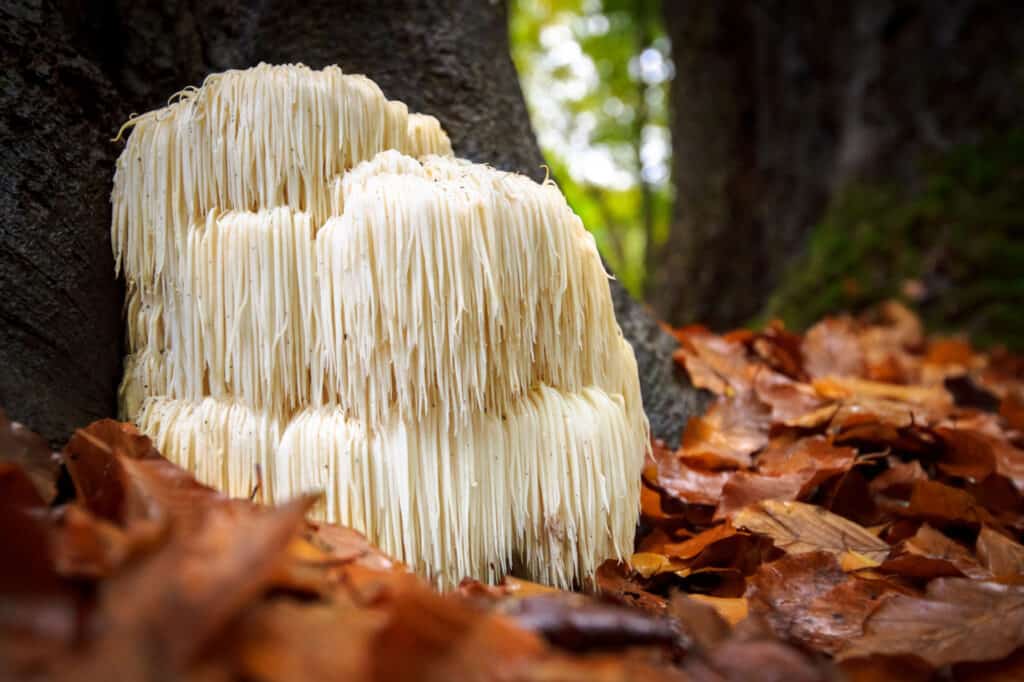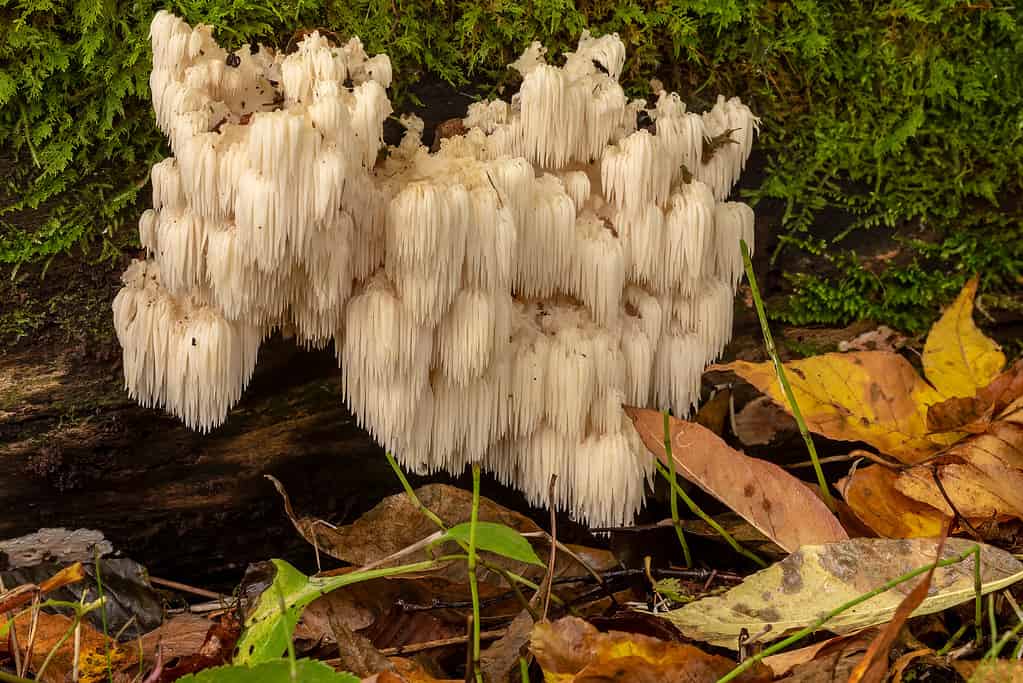If you’re a fan of natural remedies or mushrooms, you’ve likely heard of the lion’s mane mushroom.
This edible mushroom is a delightful delicacy that can be used in various dishes. In addition to being tasty, lion’s mane mushroom also includes a biochemical mix of substances that are piquing medical researchers’ growing interest. Such substances include beta-glucans, hericenones, and erinacines, which are substances with medicinal potential for treating problems like inflammation and skin aging as well as illnesses including dementia, diabetes, and cancer.
Although lion‘s mane mushroom extract hasn’t been studied for its potential adverse effects, traditional Chinese medicine and cuisine have used lion’s mane mushrooms for decades without incident. If you want to be extra cautious, see a doctor before beginning to consume lion’s mane mushroom supplements or adding this useful fungus to your diet. Better safe than sorry!
So, is it possible to grow this type of mushroom at home? While it might be easier to forage for this mushroom, you can definitely give growing it at home a shot. Just keep in mind that you’ll need to follow the steps very carefully to avoid contamination.
In this guide, we’ll break down how to produce your very own lion’s mane mushrooms at home. But first, let’s take a look at some important facts about this fascinating fungi.
What Do Lion’s Mane Mushrooms Look Like?
Several mushrooms in the Hericium genus go by the popular name “lion’s mane mushroom.” Hericium erinaceus, Hericium americanum, and Hericium coralloides are the three primary lion’s mane mushroom species. All three species are extremely similar from a gastronomic and horticultural standpoint. However, many mycologists believe that Hericium erinaceus is the one genuine lion’s mane mushroom. In order to keep this article concise, we’ll concentrate on how to produce this species specifically.
Large snowball-like growth patterns are produced by the lion’s mane mushroom. The mushroom is white, occasionally becoming brown with age or injury to the spines. Mushrooms come in a variety of sizes and weights, occasionally exceeding a pound in weight. The spines or teeth begin at a small size and enlarge with time. The mushroom is occasionally semi-hollow and spongy. When developing, it is delicate to direct spraying and readily bruises.
This kind of mushroom is quite easy to find because of its distinctive look. The icicle-like teeth dangling from a central stalk are the most reliable method to recognize lion’s mane mushrooms. This useful mushroom has a white ball appearance in its prime that is coated with shaggy spines. As these adaptogenic mushrooms are suitable for ingestion, their small spines, which resemble a lion’s mane, develop to a length of around two inches. Lion’s mane mushrooms mature and become somewhat yellow in hue with time. The mushroom is still fine to eat even if it has a faint yellow tint. However, Hericium erinaceus is past its prime once it becomes an orange hue. In order for an orange lion’s mane to generate spores as it decomposes, you should leave it on the tree if you locate one.

Lion’s mane mushrooms (pictured) don’t have many lookalikes and are easy to spot when foraging.
©Fotografiecor.nl/Shutterstock.com
Where Do Lion’s Mane Mushrooms Grow?
Lion’s mane mushrooms can be found on dead logs and hardwood trees. On live trees and hardwood logs, primarily beech, maple, and oak trees, wild lion’s mane mushrooms can be found sprouting. Their native habitat is often a rich forest in the northern regions of Europe, Asia, and North America. They prefer milder weather that is regularly between 65 and 70 degrees F. The late summer and early fall are the best seasons for foraging lion’s mane mushrooms. The best time to go foraging in North America is from August through November.
Because of their widespread use, lion’s mane is simple to get from farmer’s markets and dried from online shops. You can even purchase a growing kit and grow lion’s mane mushrooms at home. However, in this article, we’ll focus on a more DIY approach to growing lion’s mane mushrooms at home.
Lion’s Mane Mushroom Health Benefits
Due to its role in the creation of nerve growth factor proteins, the lion’s mane mushroom has been linked to studies on its possible health benefits. It appears to increase brain function and neuronal health, minimize oxidative stress, and relieve the symptoms of dementia.
The following are only a few benefits of lion’s mane mushrooms:
- Lowers the signs and symptoms of ADHD, anxiety, and depression.
- Enhances general brain health and cognitive function, including learning and memory, by reducing inflammation and oxidation.
- Boosts neurite outgrowth, enhances mental clarity, and lowers the risk of heart disease and blood clots.
- Lowers the chance of mild cognitive impairments and Alzheimer’s disease.
- Decreases blood sugar levels, helps treat diabetes, promotes cancer cell death, and may be able to treat cancer.
- Enhances digestion and guards against stomach ulcers.
- Decreases nerve damage in neurodegenerative autoimmune illnesses like Parkinson’s disease.
- Enhances immune function.
- Boasts potential neuroprotective qualities.
A culinary delight, the lion’s mane mushroom is also incredibly adaptable in the kitchen. It is a great substitute for meat in many meals, particularly chicken. Its spongy structure allows it to absorb any flavor that is cooked into it. This mushroom can be sliced lengthwise and fried in a skillet. When cooked in a skillet and covered with melted butter, many foodies believe that lion’s mane mushroom makes a fantastic imitation of lobster.
Growing Lion’s Mane Mushrooms at Home
The lion’s mane mushroom can be grown indoors using a number of simple methods. The number of mushrooms you want to cultivate and your degree of mushroom growing experience will determine which approach is ideal for you. For the sake of brevity, we’ll concentrate on how to produce lion’s mane mushrooms from scratch for beginners.
Everything you need to know about cultivating lion’s mane mushrooms with spawn obtained from a spawn supplier is covered in the step-by-step guide below. To start, you’ll need the following supplies:
- Hericium erinaceus spawn
- Containers for growing your mushrooms
- Mushroom grow bags
- Measuring cups
- A kitchen scale
- A large bowl
- A pressure cooker
- Wooden pellets
- Wheat bran
- Water
Tree surgeons and landscaping businesses usually offer wood pellets for free or at a cheap cost. If you’re going to do this, request hardwood pellets specifically. You can use wheat or oat bran as the nitrogen-rich supplement in your substrate, although we advise opting for wheat. Opt to buy your lion’s mane mushroom grain spawn from a reputable online retailer.
1. Get Your Lion’s Mane Substrate Ready
The substrate’s main function is to give the lion’s mane mycelium a moist, nutrient-rich food supply to help it grow. Hardwood pellets mixed with bran makes an excellent and accessible substrate for this mushroom species.
On their own, hardwood pellets don’t require sterilization. This is accomplished by the heat and pressure of the pellet manufacturing process. Nevertheless, adding wheat bran necessitates sterilizing the entire combination.
You will need roughly five cups of hardwood pellets, one heaping cup of bran, and six cups of water to form a sizable block of substrate. In a bucket or large dish, combine the pellets with water, and let them soak for half an hour. The pellets will fragment and turn into sawdust. Although it is not required, using warm water speeds up the process. Sawdust and bran should be combined until the bran is uniformly distributed.
Make sure the substrate has the appropriate amount of water. Squeeze your substrate just a little bit to test how damp it is. There should be a few water drops that come out. It’s too wet if a lot of water leaks out. The substrate is too dry if no water comes out and it doesn’t hold together in your hand. Once you’ve adjusted the moisture levels of the substrate, fill a mushroom grow bag with the mixture, press out as much air as you can, and fold the bag as directed. You will likely need multiple bags.
Now, sanitize the substrate for approximately two to three hours at 15 PSI in your pressure cooker. Before starting the inoculation process, give your substrate at least eight hours to cool down. You don’t want to handle hot substrate.
2. Start Inoculating and Incubating Your Substrate
The procedure of combining your substrate with lion’s mane mushroom spawn is called inoculation. To prevent contamination, thoroughly wash your hands with soap and water before beginning and wipe off any work surfaces. Some mycologists prefer to wear latex gloves.
Now, add about 5% or so of your lion’s mane spawn to each bag of the wet and sanitized substrate. Mix the spawn and substrate together and secure the bag’s top with a rubber band or clip. Close the bag and let it incubate in a warm, dark place that is between 70 and 75 degrees F. The lion’s mane spawn will develop, proliferate, and colonize the substrate as it spreads throughout the bag. Your lion’s mane substrate needs two to three weeks to completely colonize. Be patient!
3. Prep Your Bags for Fruiting
After two to three weeks, the colonization process will be complete. Now, it’s time to prepare your lion’s mane mushroom colony for fruiting. The best fruiting conditions will be between 60 and 75 degrees F. Humidity should be around 90%, so you may need to invest in a humidifier for this part of the process. Light exposure should be around 750 to 1,000 lux and the Co2 levels should be around 750 to 1,000 ppm.
Take the grow bags and slice two three to four-inch slits in each bag. This is where the mushrooms will grow out of. You’ll notice pinhead-sized or primordial growth on your substrate after about a week. Depending on the temperature, they will develop into full-sized mushrooms and will be ready to be harvested in another seven to 10 days. Soon after your lion’s mane mushrooms begin to fruit, you’ll be able to harvest and eat them. In as little as two weeks, you could be feasting on delicious, fresh lion’s mane mushrooms!

Lion’s mane mushrooms (pictured) grow best in high humidity.
©Karel Bock/Shutterstock.com
4. Harvest Your Lion’s Mane Mushrooms
When the size of the mushrooms stops expanding and the spines lengthen and thicken, the lion’s mane mushroom is finished developing. For the best flavor and texture, you must harvest them before they turn yellow or brown.
You can harvest your lion’s mane mushrooms at various ages to obtain various textures. Young lion’s mane mushrooms are stiffer and denser. The fruitbodies are ready to be picked if they feel like they will detach from the bag easily. They probably aren’t quite ready if there is resistance and you feel like you would need to take them off with a lot of force. Again, these are mushrooms you’ll have to be patient to enjoy properly.
The content on this page is for informational purposes only and may contain inaccuracies. Please verify all information independently. AZ Animals says: do not eat any wild mushrooms or plants without firsthand knowledge that they are safe for consumption.
The photo featured at the top of this post is © Fotografiecor.nl/Shutterstock.com
Thank you for reading! Have some feedback for us? Contact the AZ Animals editorial team.







